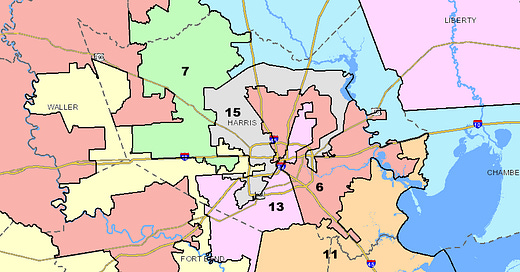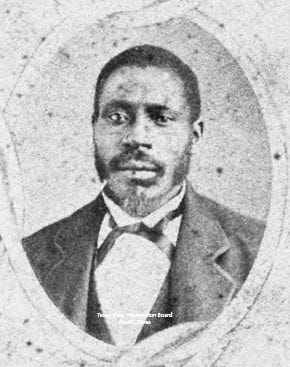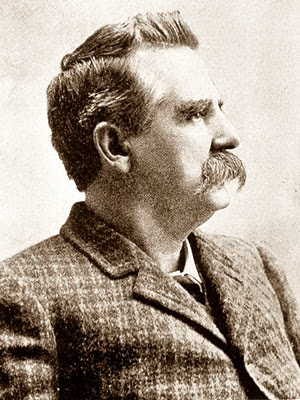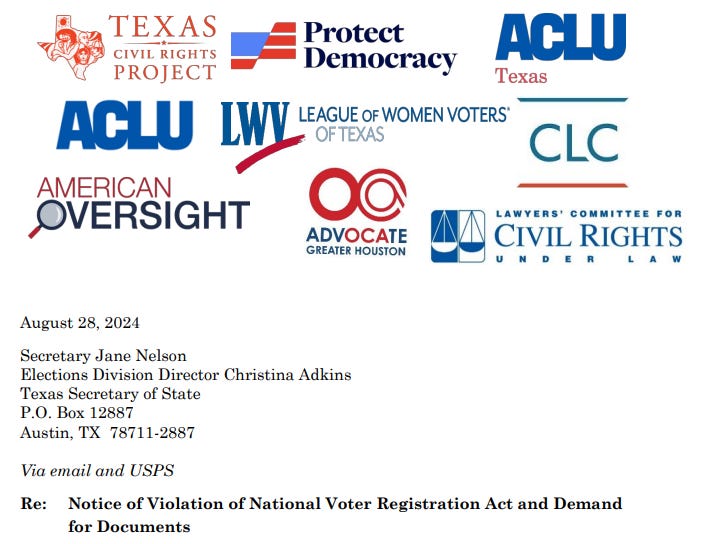From Poll Taxes to Gerrymandering: The Persistent Threat To Democracy In Texas
How Texas’s legacy of disenfranchisement continues to shape its political landscape.
Voter suppression in Texas is not just a relic of the past; it’s a persistent force that has shaped the state’s political landscape from its inception. The ink was barely dry on the 15th Amendment when white conservatives began devising new ways to silence the voices of people of color. Today, as Governor Greg Abbott and Attorney General Ken Paxton spearhead efforts to suppress voters, we are witnessing a disturbing continuation of this legacy—modern tactics with the same age-old purpose: to undermine democracy by excluding those who threaten their grip on power.
To understand the gravity of what’s happening today, we need to look back at the long history of voter suppression in Texas. From the poll taxes and literacy tests of the Jim Crow era to the gerrymandering and voter ID laws of recent decades, each tactic has been carefully crafted to maintain power by keeping certain voices out of the democratic process.
A brief history of voter suppression in Texas.
Walter Moses Burton.
Walter Moses Burton (1829-1913) was the first Black sheriff elected to office in Texas and the United States. He also was the last Black person elected to the Texas Senate (1874) until Barbara Jordan’s election in 1966.
Senator Burton was a voice for justice during his time in office, but he almost wasn’t elected due to the disenfranchisement efforts of Confederate veterans in Wharton County. Burton’s name appeared on the ballot as “W. M. Burton.” However, the Wharton County Democratic Party printed and handed out ballots that said “Wm Burton.” (In the 1800s, “Wm” was shorthand for “William.”) It wasn’t a mistake but a calculated and malicious effort by white Conservatives to stop Senator Burton from being elected.
(Remember, Democrats were the Conservative Party until the 1960s.)
Burton’s election had to be determined in the courts in early 1874. The court found that multiple ballots were printed to trick voters into voting for “William Burton” instead of “W. M. Burton.” Fortunately, the court ruled that Burton was legitimately elected despite the hundreds of votes on fake ballots.
Walter Moses Burton was born into slavery and then became a Texas Senator who fought for education and equal justice under the law. He was victorious against the forces of disenfranchisement, a testament to his determination and resilience. He earned his rightful place in Texas history.
Alexander Watkins Terrell.
Alexander Watkins Terrell (1827–1912) was another prominent figure in Texas history. Terrell was an enslaver and a military officer for the Confederate Army. After Reconstruction, he served in the Texas Legislature (both the House and the Senate) for sixteen years.
Alexander Terrell created the Terrell Election Law, which gave Texas “whites-only primaries” and poll taxes.
“Every reading man knows that last winter before this law passed, poll taxes had to be paid. As many as 600 were paid by one man in one city and peddled out by him to heelers. White tramps. Mexicans and negroes to overwhelm the vote of honest men.”
This 1904 speech Terrell gave in Fort Worth about his election laws proved that the election laws were meant to disenfranchise non-white voters specifically. He claimed that a wealthy man paid the poll tax for as many as 600 people and that houseless white people, Hispanic, and Black voters overwhelmed the vote of “honest men.” By honest, he meant white property owners.
Terrell’s legacy is a dark reminder of how laws can be weaponized to strip away the rights of those deemed unworthy by those in power.
The 1965 Voting Rights Act.
There was a common belief in the 1970s that the Voting Rights Act of 1965 didn’t apply to Texas because Texas didn’t enforce literacy tests when it was initially enacted. However, it was still illegal to prevent people from voting, but Texas wasn’t subject to preclearance until 1975 (Otherwise known as Section 5 of the Voting Rights Act of 1965).
The VRA was renewed in 1970 for five years and ten years in 1975, but that’s when Texas got worked up because the 1975 renewal also included an amendment that would require Spanish ballots for Spanish-speaking voters. Something Texas hadn’t been doing up until that point, which disenfranchised hundreds of thousands of Spanish-speaking Texans.
The 1975 Texas Secretary of State Mark White Jr. (who later became Texas Governor) said there was no evidence of voting rights violations in Texas and that applying the provisions of the Act to Texas would be a fraud and an insult. White was even characterized as waging a crusade against the new extension of the Voting Rights Act.
This extension was shepherded through Congress by Texas’ own Barbara Jordan.
Almost immediately after the VRA was extended, Governor Dolph Briscoe filed a lawsuit against the Federal Government to keep them out of Texas’ elections.
Fortunately, the suit was blocked by federal courts.
As Texas has always done, the 1975 State Legislature passed a new election bill, making voting harder.
The 1976 assassination of Frank J. Robinson.
Frank J. Robinson, the grandson of enslaved people, was born in 1902 in Smith County, Texas. Robinson grew up in Antioch and settled in Palestine after graduating from Prairie View College. He became the superintendent of Butler School District and retired in the early 1960s.
After he retired, Frank J. Robinson wanted to focus his life and efforts on education and voting rights in Deep East Texas. Robinson organized Black leaders, started the Anderson County Civic League (ACCL), and organized local, regional, state, and national voting rights activists. Soon after, he became the public relations director for the East Texas Leadership Forum and the face of voting rights activism in East Texas.
In 1974, Frank J. Robinson and several others sued Anderson County over the racially gerrymandered commissioner court precinct lines, diluting the Black voting power. Robinson won, which led to the commissioner’s court lines being redrawn fairly and equally.
Robinson transformed the political landscape in East Texas.
On October 13, 1976, Frank J. Robinson was gunned down in his home. Despite the narrative and evidence, Frank J. Robinson’s death was considered suicide. That conclusion was challenged in 1976 and is still being challenged today.
Tom DeLay and the 2003 Redistricting.
The 2003 redistricting in Texas, led by then-US House Majority Leader Tom DeLay, fundamentally reshaped the political landscape of Texas and had far-reaching implications for national politics.
This was the first time Democratic legislators fled the state—first to Oklahoma and later to New Mexico—in an attempt to block the redistricting plan by denying the Texas Legislature the quorum needed to pass the legislation. Despite these efforts, Republicans eventually prevailed, and the new map was approved.
The redistricting was a major success for Republicans. It led to a significant shift in Texas’ congressional delegation from a near-even split to a Republican majority. In the 2004 elections, Republicans gained five additional seats, solidifying their control. It also assured Republicans’ total control of the Texas Legislature.
The plan faced several legal challenges, including a case that went to the US Supreme Court. While the Court upheld most of the redistricting plan, it did rule that one of the districts (District 23) violated the Voting Rights Act because it diluted Hispanic voting strength. This led to further redrawing of the district lines.
Shannon Perez vs. the State of Texas.
The 2013 Supreme Court decision in Shelby County v. Holder weakened the Voting Rights Act by eliminating the preclearance requirement. This decision had a profound impact on Texas, as it immediately led to the implementation of stricter voter ID laws and other measures that have been criticized as modern forms of voter suppression.
Perez vs. Texas was a lawsuit in which plaintiffs sought to amend the 2013 redistricting maps and prevent them from being used in the next elections. While Texas would go on to win this lawsuit, I want to bring your attention to something then-Attorney General Greg Abbott said.
DOJ’s accusations of racial discrimination are baseless. In 2011, both houses of the Texas Legislature were controlled by large Republican majorities, and their redistricting decisions were designed to increase the Republican Party’s electoral prospects at the expense of the Democrats. It is perfectly constitutional for a Republican-controlled legislature to make partisan districting decisions, even if there are incidental effects on minority voters who support Democratic candidates, which is implicated only where Democrats lose because they are black, not where. The redistricting decisions of which DOJ complains were motivated by partisan rather than racial considerations, and the plaintiffs and DOJ have zero evidence to prove the contrary.
What Abbott was saying here is that Republicans were well aware that their 2011 and 2013 redistricting efforts disenfranchised Black voters. Still, they intended to disenfranchise Democrats, and it’s not their fault that Black voters happen to be Democrats. Basically, he suggested that the primary goal was to weaken Democratic political power, and any impact on Black voters was a consequence of their alignment with the Democratic Party rather than a targeted racial strategy.
This “disenfranchise Democrats, but not people of color” strategy is the one Republicans are still rolling with today.
In 2021, Senator Joan Huffman was “blind to race.”
Once again, Republicans were in control when the 2021 redistricting came around. Our current gerrymandered maps were drawn to keep Republicans in power, despite white people now being a minority in Texas, and to diminish the Black, Hispanic, and Asian vote, which typically align with Democrats.
When the Texas Senate held redistricting hearings, hundreds of people testified for four days. Each claimed that these new maps disenfranchised communities of color. And like a broken record, over those four days, Senator Joan Huffman (R) repeated again and again that she “drew the maps blind to race.”
In one exchange between Huffman and Senator Borris Miles (D), Huffman even admitted that her maps would have violated Section 5 of the Voting Rights Act if it had remained intact.
And as our world continues to progress and our society continues to move forward, white Conservative politicians in Texas are still trying to stop people of color from voting.
Today - Greg Abbott and Ken Paxton are still at it.
Last week, Attorney General Paxton raided the homes of Democrats in South Texas, including 70 and 80-year-old grandmothers who volunteer with LULAC. This came on the heels of LULAC endorsing Kamala Harris, their first political endorsement in their 100-year history.
On Monday, Governor Abbott announced that the state has removed roughly a million people from its voter rolls since he signed a legislative overhaul of election laws in 2021.
It should be noted that in 2019, Texas attempted to remove 100,000 naturalized citizens from the voter rolls, which resulted in a lawsuit and settlement.
Yesterday, Ken Paxton announced the creation of an “Illegal Voting Tipline,” where you can report your Democratic neighbors and Black co-workers for voting.
Abbott’s announcement this week resulted in this letter:
You can see the full letter here. The letter demands that Texas immediately cease unlawful activity and asks that Texas promptly provide records as to the recent removal of thousands of voters from the state’s rolls, given the potential for erroneous disenfranchisement of many Texas voters.
LULAC has asked the Department of Justice to open an investigation into Ken Paxton’s anti-democracy actions. The DOJ has not yet responded.
Your vote is so important that Conservatives have been trying to take it away for more than a century.
The right to vote is the cornerstone of our democracy, and it has been fiercely contested and defended throughout Texas history. The struggles of those who came before us, from Walter Moses Burton to Barbara Jordan, remind us that equality and fairness have never been easily won—they are the results of relentless determination and courageous action.
Today, we stand at a crossroads where our votes are more critical than ever. It’s up to each and every one of us to honor the legacy of those who fought for our rights by casting our ballots and making our voices heard.
We must vote in numbers so overwhelming that no amount of gerrymandering, voter suppression, or intimidation can silence us. This is our moment to protect Texas’s future and ensure that our state reflects the values of fairness, justice, and equality for all.
Vote early, vote often, just vote.
October 7: Last day to register to vote.
October 21: First day to early vote.
October 25: Last day to apply for a mail-in ballot.
November 1: Last day to early vote.
November 5: Election day!
LoneStarLeft’s Newsletter is a reader-supported publication. To receive new posts and support my work, consider becoming a free or paid subscriber.
Follow me on Facebook, Twitter, TikTok, Threads, YouTube, and Instagram.








Thanks for a very informative article.
I totally agree with your statement, “ We must vote in numbers so overwhelming that no amount of gerrymandering, voter suppression, or intimidation can silence us. This is our moment to protect Texas’s future and ensure that our state reflects the values of fairness, justice, and equality for all.”
Amen 🙏.
Thank you, Michelle, for this in-depth history of voter suppression in this state. I find it shocking that it is justifiable in Texas (and elsewhere) to draw precinct/district maps based on political party affiliation and then having the gall to say it isn’t racially biased. Voting districts should be more like the shape of most counties in Texas: square! Instead, they have shapes that look like someone threw scrambled egg at the wall.
SIDEBAR: I was a bilingual poll worker for ten years and often explained to Hispanics how to properly fill out a paper ballot before there were computers where you just had to push buttons and get a print-out of your ballot. One of my cherished memories is of a very elderly Hispanic gentleman (85 years old) who was voting for the first time in the presidential election in 2016. He was a naturalized citizen, but only minimally literate in English. His daughter had encouraged him to get registered and helped him complete all the paperwork. I explained how he had to blacken the circles next to his choices on the ballot carefully so the machine would not reject it. This was tricky because there were poll watchers sniffing around like bloodhounds. One of them was giving me the stink eye as he watched me explain everything in Spanish to this man, but he couldn’t accuse me of anything because I was following all the rules to the letter, which included having to *point* to the ballot without *touching* it. (Poll workers are not allowed to just hand a voter a blank ballot.) After he proudly deposited his ballot in the machine, he came back to my table with a huge grin on his face and said: “Voté por la señora.” = I voted for the lady. The "lady" was Hillary Clinton, of course.